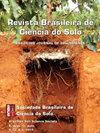Liming and grazing intensities effects on soil mineral nitrogen throughout the pasture cycle in a subtropical integrated crop-livestock system
IF 2
4区 农林科学
Q3 SOIL SCIENCE
引用次数: 2
Abstract
: Grazing intensity is a preponderant factor for the success of integrated crop-livestock systems (ICLS). Management of grazing intensity impacts soil organic matter (SOM) dynamics, soil reacidification process, and amount and quality of residues added to the ICLS. Consequently, the soil mineral nitrogen (N) forms may present different behavior throughout the pasture cycle, because they are directed linked to SOM and soil acidity dynamics. This study aimed to evaluate the impact of grazing intensities and liming in the temporal variation of acidity and mineral N forms in soil surface (0.00-0.20 m) and subsurface (0.20-0.40 m), throughout the pasture cycle of an ICLS under an Oxisol in the Brazilian subtropics. The study was performed 11 years after the beginning of the field experiment, characterized by the cattle grazing in a winter pasture of oat + ryegrass during the winter and soybean cropping during the summer. The experimental design is randomized block with three replicates, where the grazing intensities are in the plots and liming is the subplots. The grazing intensities were defined as grazing sward height management, being 0.10, 0.20-0.30, and 0.40 m defined as intensive (IG), moderate (MG) and light grazing (LG), respectively. We evaluated the soil ammonium (N-NH 4+ ), nitrate (N-NO 3- ), mineral N and pH at 45, 70, 156 and 192 days after pasture sowing (DAPS). Our results showed that grazing intensities only affected the soil pH at the end of pasture cycle, with MG presenting higher pH than IG and LG, regardless of liming. A decrease of soil N mineral stocks was observed throughout the pasture cycle in all managements, due to the decrease of soil N-NO 3- stocks in the surface and subsurface layers and of N-NH 4+ only in the surface layer. The influence of grazing intensities was only observed for N mineral forms in limed areas before the beginning of grazing. At 45 DAPS, MG and LG presented the highest and the lowest N-NH 4+ , respectively. At 70 DAPS, the behavior was inverse, and LG presented the highest N-NO 3- stock and the MG and IG the lowest N-NO 3- stocks. With such results, it is possible to conclude that there is an influence of grazing intensity and liming in the temporal variation of soil pH and mineral N forms in ICLS and this may be utilized for improvements in N fertilizer management, mainly before the starting of winter grazing.亚热带农牧一体化草地循环中石灰和放牧强度对土壤矿质氮的影响
放牧强度是作物-牲畜综合系统(ICLS)成功的主要因素。放牧强度管理影响土壤有机质动态、土壤再酸化过程以及ICLS中添加残留物的数量和质量。因此,土壤矿质氮(N)形态可能在整个牧草循环中表现出不同的行为,因为它们与土壤有机质和土壤酸度动态直接相关。本研究旨在评估放牧强度和石灰化对巴西亚热带Oxisol下ICLS整个牧草循环中土壤表层(0.00-0.20 m)和地下(0.20-0.40 m)酸度和矿质N形态的时间变化的影响。该研究是在田间试验开始11年后进行的,其特点是冬季在燕麦+黑麦草的冬季牧场放牧,夏季种植大豆。试验设计为随机区组,设3个重复,放牧强度为样地,放牧界线为子样地。放牧强度定义为放牧草地高度管理,分别为0.10 m、0.20 ~ 0.30 m和0.40 m,定义为集约(IG)、中度(MG)和轻度放牧(LG)。研究了播后45、70、156和192 d土壤铵态氮、硝态氮、矿质氮和pH的变化。结果表明,放牧强度仅在放牧周期结束时影响土壤pH值,无论封泥与否,MG的pH值均高于IG和LG。在整个牧草循环过程中,所有管理方式的土壤N矿物储量均呈减少趋势,这是由于表层和次表层土壤N- no3 -储量减少,而N- nh4 +仅在表层减少。放牧强度只对放牧开始前石灰区氮素矿物形态有影响。在45 DAPS时,MG和LG的n - nh4 +含量分别最高和最低。在70 DAPS时,N-NO -储量表现为LG最高,MG和IG最低。由此可以得出结论,放牧强度和封石灰对ICLS土壤pH和矿质氮形态的时间变化有影响,这可能用于改善氮肥管理,主要是在冬季放牧开始之前。
本文章由计算机程序翻译,如有差异,请以英文原文为准。
求助全文
约1分钟内获得全文
求助全文
来源期刊

Revista Brasileira De Ciencia Do Solo
农林科学-土壤科学
CiteScore
3.00
自引率
11.80%
发文量
32
审稿时长
9-24 weeks
期刊介绍:
The Revista Brasileira de Ciência do Solo is a scientific journal published by the Brazilian Society for Soil Science (SBCS), founded in 1947, and is responsible for the propagation of original and inedited technical-scientific work of interest for Soil Science.
Contributions must not have been previously published or submit to other periodicals, with the only exception of articles presented in summarized form at professional meetings. Literature reviews are accepted when solicited by the Editorial Board.
 求助内容:
求助内容: 应助结果提醒方式:
应助结果提醒方式:


